| 'Like' us on Facebook | Follow us: |
Posted on: Apr 20, 2020
THE SAI PANCHARATNA KRITIS - 6
Part 1 | Part 2 | Part 3 | Part 4 | Part 5
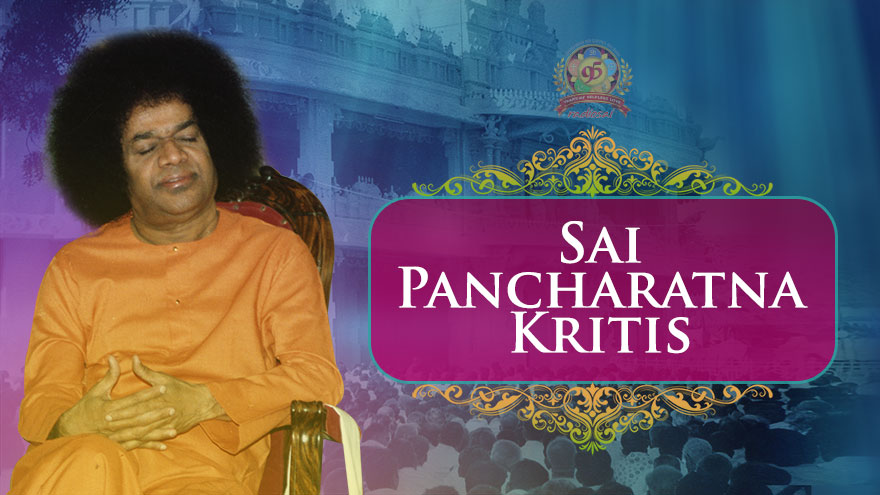 |
The Sai Pancharatna Kritis are special Carnatic compositions describing the life story and the glory of the Sathya Sai Avatar. They were first presented at the Lotus Feet in the year of Swami's 90th Birthday on Aradhana Day 2015.
| Sai Pancharatnas | Lyrics and Meaning |
| Sai Pancharatnas | Tutorial |
Sai Pancharatnas – Complete Audio of the five kritis
| 1) Pranamami Sayeesha | Download |
| 2) Sada Bhavayami | Download |
| 3) Charana Sevanam | Download |
| 4) Kaliyuga Avatari | Download |
| 5) Sathya Sai Avatara Vaibhavam | Download |
Subsequent to this presentation, in answer to many devotees' queries, we had many live Radio Sai discussions about the making and the meaning of these compositions in our programs “Outside Inside Deep Inside” as well as “Morning Glory”.
| Outside Inside Deep Inside Discussions | Morning Glory Discussions |
Presented below are edited excerpts of the third 'Outside Inside Deep Inside' discussion which had as its participants, Radio Sai team members, C. G. Sai Prakash (CG), Anirudh Srinivasan (AS), and Bishu Prusty (BP), as well as Ms S V Vasumathi (SVV), the Vice Principal of Sri Vishwa Vidyalaya Matriculation High School, Chennai.
In this episode they dwell on the musical beauty as well as profound depth of the lyrics of the second Sai Pancharatna Kriti – “Sada Bhavayami”.
The Meaning and Significance of the Second Kriti
CG: Now we move on to the second kriti which embodies all the divine aspects of Bhagawan. I am almost tempted to say that this kriti lists the 16 kalas of the Avatar!
That is because each charanam is so potent and so full of meaning. The raga chosen for this kriti is Mayamalavagowla, which is the first raga taught to beginners who learn Carnatic music. I don't know what prompted Raj Kumar Bharathi Sir to choose this raga for such a glorious theme of the divine aspects of Bhagawan but when you listen to the kriti, you will realise that it is the perfect raga.
AS: Let me tell the notes of the raga Mayamalavagowla. It has all the seven notes.
It is a beautiful raga and we have many Sai bhajans in this raga. One is ‘Matanga Vadana Ananda Sadana’.
CG: Is it a morning raga?
AS: Yes. It is very meditative. When you listen to this kriti, definitely you will close your eyes and get into a meditative mood of listening. The raga chosen is so perfect and so apt for the lyrics. In fact, this kriti is one of my favourites.
‘Swaraksharams’ – A Unique Feature
An interesting aspect in this pallavi is that in the first phrase ‘Sada Bhavayami’, the notation for the word ‘sada’ corresponds to the notes ‘sa’ and ‘da’ respectively. That is ‘swaraksharam'.
There are lot of swaraksharams in this kriti. It is a unique feature in a Pancharatna kriti. You can find it even in the phrase ‘pari poornavataram’. The word ‘pari’ has a swaraksharam because the swaras are ‘pa’ and ‘ri’ respectively. It is beautifully composed! The tune is so beautiful and melodious.
CG: Yes. When you sing a pallavi, there are three or four variations and these are also composed and predetermined, am I right?
AS: Yes.
CG: Only then it is suitable for group singing. That is one unique feature of Carnatic music where everything has been pre-composed so that group singing becomes possible.
I was just listening to the way the variations are sung and what I realised is that every ‘paripoorna’ is reaching higher. The first ‘paripoorna’ reaches till the higher ‘sa’, the second goes to the higher ‘ri’ and then the next goes to the higher ‘ma’. Every ‘paripoorna’ is more poorna or more complete! So beautiful!
BP: The Lord encompasses everything and when you want to give an idea of that you try and sing it in three-four ways.
CG: Swami is everything. How fortunate are we who lived with Him and learnt from Him! We were in the presence of the One who has anything and everything in His control and who is the embodiment of every beautiful thing and everything that is good.
You can take the liberty of saying anything because everything is right! ‘Paripoorna Avataram’ is so apt.
The anupallavi of this kriti has the words, ‘Sada nadopasita modam maya manusha vesha dharam’.
The meaning of the anupallavi is, “Using maya, You have donned the human vesture and You always delight in music. You are the perfect human being.”
 |
The Central Theme of the Second kriti
One more unique structure of this kriti is that there is a refrain which keeps repeating after each charanam. It is ‘Prema tanumanisham karuna hridayam’. This is the central theme.
AS: It is there even in the structure of Tyagaraja's Pancharatna kritis. Before each new charanam gets introduced, you come back to a line and only then sing the next charanam.
CG: First you sing the main refrain, then sing the swaras of every charanam followed by the corresponding sahityam and finally sing the refrain again.
But what I found very beautiful in this kriti is ‘Prema tanumanisham karuna hridayam’. The central focus of the Avatar's life is prema or love! He is the embodiment of love with a compassionate heart or karuna hridayam.
BP: That is the best and most apt description of the Avatar!
CG: You'll see that each charanam in this kriti describes a very unique divine aspect of Bhagawan which only divinity can do. But you go back to the refrain ‘Prema tanumanisham karuna hridayam’.
That teaches us a very big lesson about His life. When you sit silently and reflect, you realise that He did everything with love. He did not materialise a ring to show that He can do it and we cannot. No! He did it with love. He gave vibhuti with love and He did vibhuti abhishekam also with love. As we go through the charanams, more and more we will realise how apt this refrain is!
 |
The First Charanam
The first charanam is ‘Vedapurusha vedaposhakam vedasararoopa vedaganalolam’. We know that in Bhagawan's Avataric mission, the first thing He did way back in the '50s was to nurture and foster the Vedas when He went to Venkatagiri and when He convened sadhu sammelans.
I don't know how many people are aware that Bhagawan conducted two Ati Rudra Mahayagnams in Venkatagiri in the fifties. He is the One who nurtured the Vedas and brought back the focus on them! This particular line is also very beautifully tuned.
The lyricist says “Sathya Sai is the embodiment of Vedas. He sustains the Vedas, is the very essence of the Vedas and enjoys the recitation of the Vedas”. This is such a beautiful point!
Again I would like to draw attention to the way it has been composed. The composition is such that it drives you towards pronouncing it clearly. I would say it is so spashtam. So clear each word is!
AS: The spacing between the syllables is such that you can write the lyrics even as you listen to the kriti being sung for the first time.
CG: Exactly! I am sorry to say this but many times, Tyagaraja's kritis get distorted when some musicians sing because the words are not clear.
BP: Many times if you don't know the language, sometimes you wonder whether it is Tamil or Telugu.
CG: Swami would say in His discourses that certain people don't understand the meaning and sing. There is a certain phrase ‘Nenu pogadakunte neekemi Rama’ which means “If I do not praise You, so what Rama?” but some people sing it like ‘Nenu pakoda thinte neekemi Rama?’
SVV: This gives the wrong meaning as “If I eat pakoda, what is Your problem?”
CG: Exactly! Swami gave a lot of importance to pronunciation of words and even the meaning. If the words and pronunciation are clear, the meaning too becomes clear. That aspect is very beautifully taken care of in the Sai Pancharatna Kritis.
SVV: Especially for this charanam which stresses on Vedam!
BP: Yes. Vedam should be chanted with absolute clarity.
 |
The Second Charanam
CG: True. The next charanam says ‘Lingodbhava bhasmabhisheka leela vilasa Parthi Shivam.’ Swami did the Lingodbhavam and Vibhuti Abhishekam for so many years in public view. That is His unique aspect.
BP: You mentioned that this kriti is all about glorifying His divine aspects. These events of Lingodbhavam and Vibhuti Abhishekam are the ones which actually shook everyone and made them realise that they are in the presence of someone who is absolutely from another world!
CG: Yes. That is divinity but again interspersed with ‘prema’ or ‘love’!
BP: That is what I really like in this kriti. It again comes back to ‘Prema Tanumanisham’!
AS: I was thinking of the first kriti where after every charanam we go back to saluting the Lord by singing ‘Pranamami Sayeesha’. Whatever be the leelas described, we salute the Lord who did those leelas.
BP: Yes but here we describe the glory and then always come back and say “It is all because You are the reservoir of love”.
The Third and Fourth Charanams
CG: True. The third charanam is also very beautiful. It says ‘Nenundaga bhayamelananuchu abhayamosage anugraha vrishti’.
Swami is the One who declared, “Why fear when I am here?” Who can declare that? Is it ego or assurance or a divine power? It is of course divine power. Who else can say, “Why fear when I am here?”
BP: Only Lord Krishna did it before in the Bhagavad Gita!
CG: Exactly! That is definitely a divine attribute of Bhagawan.
The next charanam is ‘Bhaktapamrityu haranam gatajeeva prana pradayakam’ which means “You protect devotees from death and also bring back devotees from the dead”. The famous incident of Mr. Walter Cowan is well known. There are two-three other incidents where Swami has brought back people from the dead.
BP: Even though we mention the Walter Cowan incident, I would say that is one among millions. There are so many.
CG: But we don't know them. We go back to Walter Cowan because Bhagawan allowed that to be known! That is one of His divine aspects.
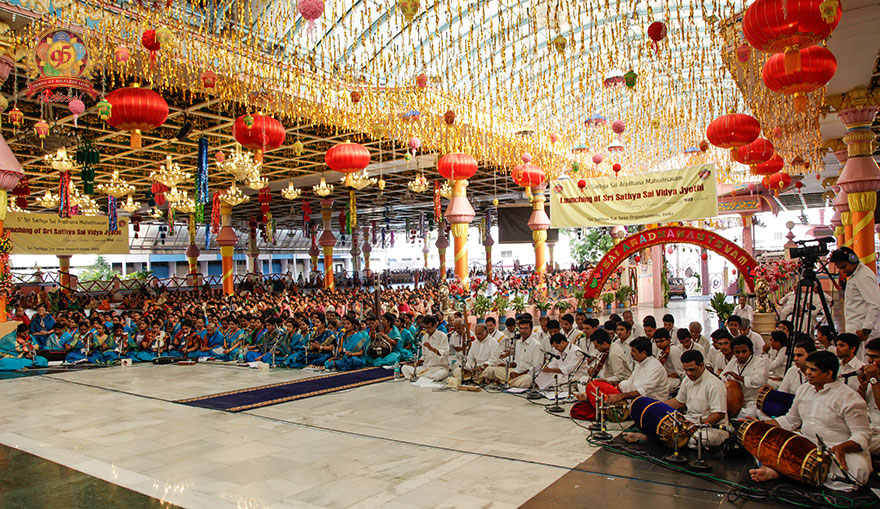 |
The Fifth and Sixth Charanams
There is a beautiful simile that the lyricist has used in the fifth charanam which says ‘Poovu puttagane parimalinchu reeti bala prayambuna tyagasheelata nerape’ which means, “Just as a flower spreads its fragrance, even from Your childhood days You taught and You lived with the virtue of sacrifice. You showed by living how one should sacrifice oneself for the happiness of others”.
Just like the flower that spreads fragrance even as it blossoms, our Lord Sathya Sai taught the virtue of sacrifice in childhood itself! We should listen to this charanam.
We all know the beautiful stories of how Swami gave His food to beggars even as a child. That was something He did till the very end too. Bishu, you rightly pointed out how He would sit and look at the clock and wait for the time He would go for darshan. He was just waiting to give Himself to everybody!
In this context, there is something very beautiful which Swami said one day when He was standing on the veranda. He casually said, “Nobody else on this earth has the eligibility to wear an orange robe.” The orange robe symbolises sacrifice. He said, “From top to toe, from the tip of My hair to My toe, I am selfless.” Always giving and sacrificing. How beautiful!
The sixth charanam says ‘Nee avatara paramarthamunu suntaina teliyudure nirvyaja prematishayamuto Ninnu neeveruka parachaninadu’. This means, “Your incarnation is so vast, so complete and so glorious that nobody can comprehend You. But You in Your boundless love allow people to comprehend a little bit of what You are. You reveal Yourself and You allow them to experience You. That is again Your compassion.”
SVV: Very nice poetical verses!
The Seventh Charanam
CG: The next charanam is also beautifully composed and the theme is very unique.
The meaning goes thus: “You are a man amongst men, child amongst children, and a woman amongst women. Thus You become the beloved God knowing each one's heart and fulfilling their desires. When alone, You are the Emperor of the Universe.”
We have seen this over and over again. When standing amidst primary school children, Swami would act as if to say, “I am not bothered about the whole world. I am only concerned about what breakfast you had and how many idlis you ate!” It's just the interest and involvement He had!
How complete was His focus! How He lived in every moment! When selecting sarees for His lady devotees, how involved He was in every detail. I don't think even a lady would fuss over her saree as much as Swami would!
SVV: Swami would give us choices. He would have two-three sarees in His hand and ask us, “Which one do you want?” I remember during one of the birthday sessions He was distributing very grand sarees to VIPs and they were very nice. The whole Kulwant Hall was lit up. The ladies side was bubbling with enthusiasm as He distributed the sarees.
Swami just had one saree when He came back towards the mandir and we old students were sitting there. It was an expensive one with a very nice colour combination. When He came back, He looked at us and then at the saree. All of us wondered what would happen.
Swami said, “No no no! Ee cheera bagaledhu (this saree is not nice). I have a better one for you.” We thought, “Wow! Will we get sarees grander than what the VIPs got?” Swami said, “Wait, I will go and get.” He went in and brought two Bengal cotton sarees. One was cream and blue and the other cream with a purple border. They were very simple and He said, “Aa cheera bagaledu (that saree was not nice), ivi chala baga undhi (these are very good). Which one do you want?”
We felt that Swami was telling us how to dress up appropriate to the age of students. So we said, “Whichever saree Swami gives is fine.” He gave us a saree each and when we had the sarees in our hands, He said, “Idhi baga undi. This is correct for you and very beautiful.”
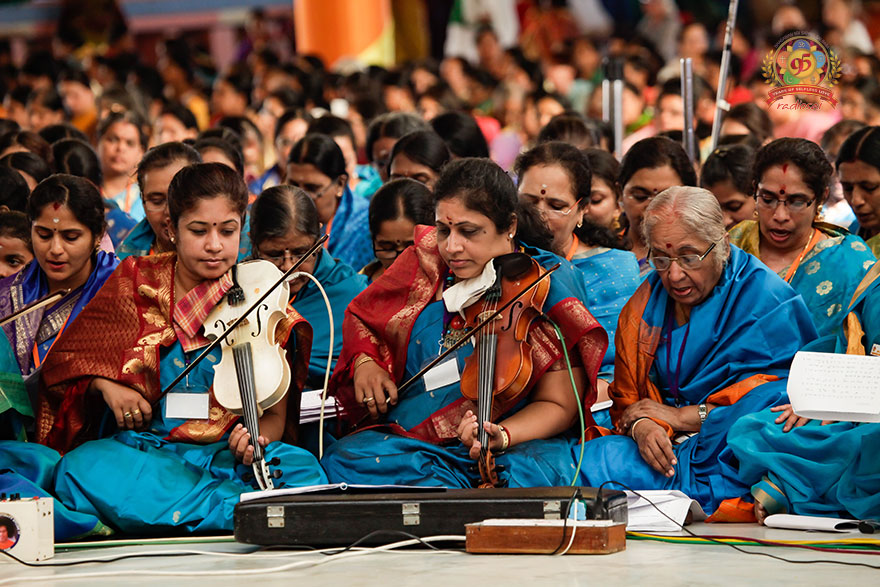 |
CG: It's not only the grandeur of the saree but what is right for you at that age and at that time.
SVV: Exactly! How we have to be in the brahmacharya stage probably. But I cannot forget the way Swami brought out the whole thing. He made all of us have our own thought process but finally concluded with this. All of us were happy receiving the sarees from His hands!
BP: Whether He gives us a saree or a car or moksha, all the time He is interested only in our spiritual progress!
CG: That is true and it comes back to ‘Prema Tanumanisham’!
I remember an incident of Swami selecting a saree in Kodaikanal. Bishu, you were also there in 1999. Swami was making such a fuss over selecting a saree. He said, “Oh! The saree is good but pallu is not good. The design is not elaborate enough. This combination is not good. Get another saree.”
Finally some of the elders could not resist and asked, “Swami, whom is this saree for? You are making such a fuss over it.” Very smilingly in a soft voice Swami said, “For the lady who washes our vessels every day!”
Immediately there was pin drop silence. We all had tears in our eyes because Swami was taking so much time and so much care to select such a grand saree for the lady who was cleaning dishes!
One of the elders made bold and said, “Swami, in her life she would have never worn such a saree.” Swami replied, “Yes, that's why I am giving it to her. Even she will have some special occasions in her life. When she wears this saree, she will remember the love with which Swami gave her the saree.”
So it is not the saree but the love with which Swami gave her the saree and that is what ‘Prema tanumanisham, karuna hridayam’ conveys. How compassionate He is!
In fact, Mr. Sachidanandam who was in Kodaikanal at that time had to go back all the way to Madurai to pick up the next choice of sarees. We were all wondering which VVIP the saree was for. But for Swami, that lady who washed the vessels was the VVIP!
BP: I remember how He materialized diamond rings for the gardeners in Kodaikanal.
CG: Exactly! That is the beautiful part of the Sai Avatar.
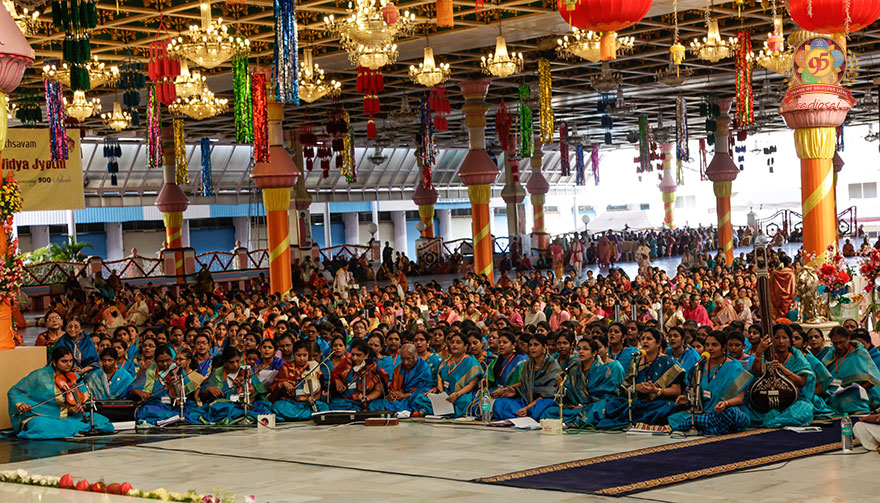 |
The Final Charanam
Now we will move on to the last charanam which starts with ‘Yuvataku anusaraneeyam...’ The meaning of this charanam is, “Your life is an ideal for the youth. You always adhered to truth and punctuality. You only spoke what is good in a controlled and soft way through appropriate mannerisms. You suffused every act with refinement and a feeling of service. Truth is Your eternal vow. Your life is Your message to the world.”
I think we must listen to this charanam.
AS: The syllables ‘sa’ and ‘ma’ in the word ‘samaya’ have swaraksharams because they correspond to the notes ‘sa’ and ‘ma’.
It is beautifully composed! The last line ‘Sai jeevitame jagatiki sandesham’ goes to a high note.
CG: Exactly! His Life is His message!
As I mentioned earlier, it is one Tyagaraja in spirit. Although the lyricist was one person and the person who tuned the lyrics was another, they are one and the same in spirit, because the compositions speak for themselves!
There is a last paragraph in this kriti. It is very beautiful and I feel it takes you from this kriti to the next one. It says ‘Deena jana sevaye Sayiki santushti’ which means, “Serving the destitute alone satisfies Sai” and ‘sarva jeevarasulapaina karunya drishti’ which means, “His compassionate gaze is on not only human beings but all living beings”.
Then comes ‘Janabhagadheya Easwaramba tanaya’ which means, “Oh! Son of Eswaramba, the bestower of prosperity on this whole universe” and ‘Mee kanusannala sagu ee sarva srishti’ which means, “The entire creation functions at Your mere glance’.
BP: The kriti is about His divinity. The highest expression of divinity is love but the highest expression of love is service!
CG: That's the point. I think we should listen to this portion too.
BP: Amazing! It's very significant that when the lyricist talks about service, she brings in Swami as ‘Easwaramba tanaya’. Swami attributed all the mammoth missions to the inspiration of Mother Easwaramma.
CG: Very true. I don't think even the lyricist thought of this while writing the lyrics! But that's how it happens. Swami has just inspired this beautiful thought. So that's how the second kriti ends.
BP: The way this paragraph starts is all about compassion and the karuna rasa is so much imbued in the way it is composed also.
CG: I don't think there are many kritis in this particular raga. For somebody to compose a Pancharatna kriti in this raga is very unique.
Now at the end of the kriti we feel the choice of raga is so relevant but many people could easily write it off as a basic raga because when one starts learning Carnatic music, this is the first raga that is taught. However, Bharathi Sir has chosen this raga and as he rightly said, “The raga has chosen the kriti!” Here is the composition and it's so beautiful, so complete and so inspiring!
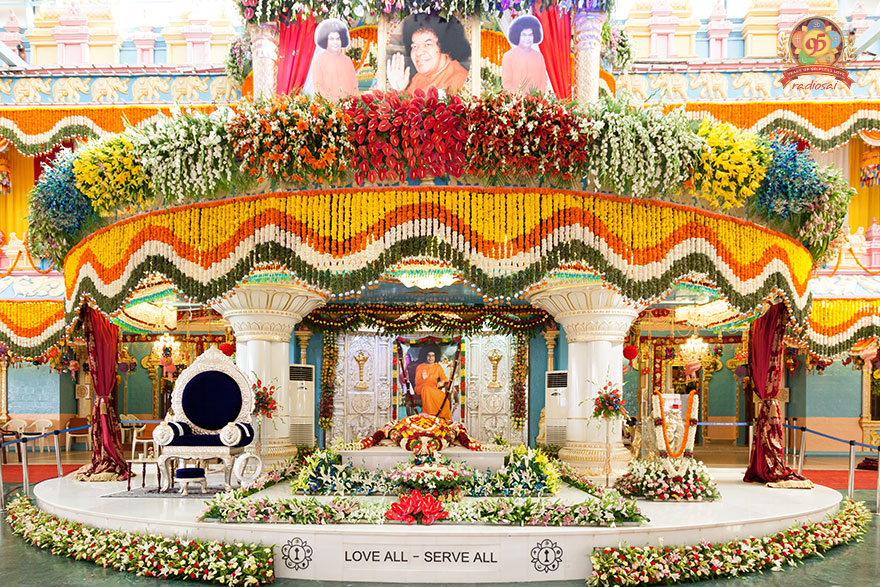 |
BP: As in the previous kriti, as we progress the charanams have more lines.
CG: Also more complicated and more beautiful!
AS: The most striking part is the last paragraph. I feel it awakens everybody and involves everyone. When a person who does not know Carnatic music listens to the last paragraph, it will make him sit up and feel that something is there. That's why we repeat this paragraph twice.
It is as if we want to allow the feeling to get established and are giving time for more people to get involved because till now we were singing swaras (notes) and sahityam (lyrics) which is the Carnatic way of rendering kritis but when this part comes it is really captivating.
CG: Very beautiful!
Part 1 | Part 2 | Part 3 | Part 4 | Part 5
| comments powered by Disqus |
What are your impressions about this? Please share your feedback by writing to h2h@radiosai.org or listener@radiosai.org . Do not forget to mention your name and country please.






